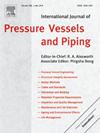裂缝长度测量误差对 Jmax 的敏感性分析
IF 3
2区 工程技术
Q2 ENGINEERING, MECHANICAL
International Journal of Pressure Vessels and Piping
Pub Date : 2025-04-04
DOI:10.1016/j.ijpvp.2025.105522
引用次数: 0
摘要
最近有报道称,Zr-2.5Nb压力管(PT)材料的最大载荷断裂韧性(Jmax)几乎不受裂纹扩展误差的影响(Δa)。为了检查Δa测量中Jmax对误差的敏感性,假设Zr-2.5Nb和zircaloy-2 PT材料以及四种不同钢在最大载荷(Pmax)之前没有裂纹扩展,计算了Jmax。对于所有6种材料,当载荷达到Pmax时,假设无裂纹扩展(Jo)的J值与基于实测Δa (Jc)计算的J值几乎相同。基于J的变形理论,建立了一个解析判据来检验Jmax对Δamax误差的敏感性。使用测量的Δamax (Jcmax)计算的Jmax与使用假设无裂纹扩展(Jomax)计算的Jmax之间建立了良好的相关性。对于断裂韧性在15-1200 kJ/m2范围内、裂纹扩展可达2.3 mm的大范围材料进行断裂试验时,利用建立的JIC和Jmax之间的关系计算Jmax和/或JIC,而不使用任何裂纹扩展测量系统,这些结果将非常有用。这对于在辐照材料等断裂试验中很难测量裂纹扩展的情况是非常有用的。本文章由计算机程序翻译,如有差异,请以英文原文为准。

Sensitivity analysis of error in crack length measurement on Jmax
Recently it was reported that maximum load fracture toughness (Jmax) of Zr-2.5Nb pressure tube (PT) material was practically unaffected by error in crack growth (Δa) measurement. To check the sensitivity of the Jmax to error in Δa measurement, the Jmax was calculated assuming no crack growth up to the maximum load (Pmax) for Zr-2.5Nb and zircaloy-2 PT material as well as four different steels. For all six materials, for load up to the Pmax, the J values calculated assuming no crack growth (Jo) were practically same as that calculated based on the measured Δa (Jc). Based on deformation theory of J, an analytic criterion was developed to check the sensitivity of the Jmax to the error in Δamax. An excellent correlation was established between Jmax calculated using the measured Δamax (Jcmax) and Jmax calculated using assuming no crack growth (Jomax). These findings will be very useful to calculate Jmax and/or and then JIC using established relationship between JIC and Jmax without any crack growth measurement system during fracture test for wide range of materials with fracture toughness in the range of 15–1200 kJ/m2 and crack extension up to 2.3 mm. This is very useful for the conditions where it is very difficult to measure the crack growth during fracture tests such as irradiated material.
求助全文
通过发布文献求助,成功后即可免费获取论文全文。
去求助
来源期刊
CiteScore
5.30
自引率
13.30%
发文量
208
审稿时长
17 months
期刊介绍:
Pressure vessel engineering technology is of importance in many branches of industry. This journal publishes the latest research results and related information on all its associated aspects, with particular emphasis on the structural integrity assessment, maintenance and life extension of pressurised process engineering plants.
The anticipated coverage of the International Journal of Pressure Vessels and Piping ranges from simple mass-produced pressure vessels to large custom-built vessels and tanks. Pressure vessels technology is a developing field, and contributions on the following topics will therefore be welcome:
• Pressure vessel engineering
• Structural integrity assessment
• Design methods
• Codes and standards
• Fabrication and welding
• Materials properties requirements
• Inspection and quality management
• Maintenance and life extension
• Ageing and environmental effects
• Life management
Of particular importance are papers covering aspects of significant practical application which could lead to major improvements in economy, reliability and useful life. While most accepted papers represent the results of original applied research, critical reviews of topical interest by world-leading experts will also appear from time to time.
International Journal of Pressure Vessels and Piping is indispensable reading for engineering professionals involved in the energy, petrochemicals, process plant, transport, aerospace and related industries; for manufacturers of pressure vessels and ancillary equipment; and for academics pursuing research in these areas.

 求助内容:
求助内容: 应助结果提醒方式:
应助结果提醒方式:


